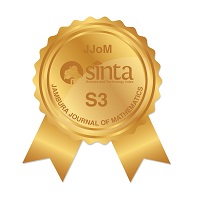On the Effects of Saturation Terms on A SEIR Epidemic Model with Infected and Susceptible Compartments
Abstract
The importance of the saturation term in an SEIR (Susceptible, Exposed, Infected, and Recovered) epidemic model was examined in this article. To estimate the basic reproduction number (R0), examine the stabilities and run numerical simulations on the model, the next generation matrix, the Lyapunov function and Runge-Kutta techniques were used. The numerical simulation results reveal that, the saturation term has a significant influence in the model's susceptible and infected compartments. However, as demonstrated by the simulation results, saturation term has a greater influence on vulnerable people than on infected people. As a result, greater sensitization programs through seminars, media, and awareness will be more beneficial to the vulnerable class than the afflicted class during disease eradication.
Keywords
Full Text:
PDFReferences
O. M. Ogunlaran and S. C. Oukouomi Noutchie, "Mathematical Model for an Effective Management of HIV Infection" BioMed Research International, vol. 2016, no. 6, pp. 1-6, 2016, doi: 10.1155/2016/4217548. [Online]. Available: http://www.hindawi.com/journals/bmri/2016/4217548/
M. K. Kolawole and M. O. Olayiwola, "Some results on the simulation of SEIRS epidemic model with saturated incidence rate for considering the saturation term for susceptible individual" Annals. Computer Science Series, vol. 15, no. 1, 2017.
M. K. Kolawole, A. I. Alaje, A. O. Popoola, and K. A. Bashiru, "Conceptual Investigation of the Disease Transmission Coefficient in Seir Epidemic Model Using Laplace Adomian Decomposition Method (LADM)" UNIOSUN Journal of Engineering and Environmental Sciences, vol. 4, no. 1, pp. 9-18, mar 2022, doi: 10.36108/ujees/2202.40.0152. [Online]. Available: https://ujees.com.ng/volume-4-issue-1-2022/609-2/
M. Kolawole, A. Alaje, M. Ogunniran, and K. R. Tijani, "Simulating the Effect of Disease Transmission Coefficient on A Disease Induced Death Seirs Epidemic Model Using the Homotopy Perturbation Method" Journal of Applied Computer Science & Mathematics, vol. 16, no. 1, pp. 40-43, 2022, doi: 10.4316/JACSM.202201006. [Online]. Available: https://www.jacsm.ro/view/?pid=33 6
M. K. Kolawole and A. A. Adeniyi, "On the Analysis of Saturation Terms on Mathematical Models for Malaria Transmission" International Journal of Research and Innovation in Applied Science (IJRIAS), vol. 5, no. 3, pp. 147-151, 2020.
T. Kolokolnikov and D. Iron, "Law of mass action and saturation in SIR model with application to Coronavirus modelling" Infectious Disease Modelling, vol. 6, pp. 91-97, 2021, doi: 10.1016/j.idm.2020.11.002. [Online]. Available: https://linkinghub.elsevier.com/retrieve/pii/S2468042720300725
O. C. Zephaniah, U.-I. R. Nwaugonma, I. S. Chioma, and O. Adrew, "A Mathematical Model and Analysis of an SVEIR Model for Streptococcus Pneumonia with Saturated Incidence Force of Infection" Mathematical Modelling and Applications, vol. 5, no. 1, pp. 16-38, 2020.
E. Bonyah, G. Twagirumukiza, and P. P. Gambrah, "Mathematical analysis of diarrhoea model with saturated incidence rate" Open Journal of Mathematical Sciences, vol. 3(2019), no. 1, pp. 29-39, dec 2019, doi: 10.30538/oms2019.0046. [Online]. Available: https://pisrt.org/psrpress/j/oms/2019/1/4/mathematical-analysis-of-diarrhoea-model-with-saturated-incidence-rate.pdf
S. Mushayabasa, "A Simple Epidemiological Model for Typhoid with Saturated Incidence Rate and Treatment Effect" International Journal of Mathematical and Computational Sciences, vol. 6, no. 6, pp. 688-695, 2012, doi: doi.org/10.5281/zenodo.1088092.
M. A. Khan, N. Iqbal, Y. Khan, and E. Alzahrani, "A biological mathematical model of vectorhost disease with saturated treatment function and optimal control strategies" Mathematical Biosciences and Engineering, vol. 17, no. 4, pp. 3972-3997, 2020, doi: 10.3934/mbe.2020220. [Online]. Available: http://www.aimspress.com/article/doi/10.3934/mbe.2020220
S. Ullah, M. F. Khan, S. A. A. Shah, M. Farooq, M. A. Khan, and M. bin Mamat, "Optimal control analysis of vector-host model with saturated treatment" The European Physical Journal Plus, vol. 135, no. 10, p. 839, oct 2020, doi: 10.1140/epjp/s13360-020-00855-1. [Online]. Available: https://link.springer.com/10.1140/epjp/s13360-020-00855-1
A. Suryanto and I. Darti, "On the nonstandard numerical discretization of SIR epidemic model with a saturated incidence rate and vaccination" AIMS Mathematics, vol. 6, no. 1, pp. 141-155, 2021, doi: 10.3934/math.2021010. [Online]. Available: http://www.aimspress.com/article/10.3934/math.2021010
A. A. Thirthar, R. K. Naji, F. Bozkurt, and A. Yousef, "Modeling and analysis of an SI1I2R epidemic model with nonlinear incidence and general recovery functions of I1" Chaos, Solitons & Fractals, vol. 145, p. 110746, apr 2021, doi: 10.1016/j.chaos.2021.110746. [Online]. Available: https://linkinghub.elsevier.com/retrieve/pii/S0960077921000990
L. Li, C. Sun, and J. Jia, "Optimal control of a delayed SIRC epidemic model with saturated incidence rate" Optimal Control Applications and Methods, vol. 40, no. 2, pp. 367-374, mar 2019, doi: 10.1002/oca.2482. [Online]. Available: https://onlinelibrary.wiley.com/doi/10.1002/oca.2482
D. Bentaleb, S. Harroudi, S. Amine, and K. Allali, "Analysis and Optimal Control of a Multistrain SEIR Epidemic Model with Saturated Incidence Rate and Treatment" Differential Equations and Dynamical Systems, aug 2020, doi: 10.1007/s12591-020-00544-6. [Online]. Available: https://link.springer.com/10.1007/s12591-020-00544-6
M. A. Khan, Y. Khan, and S. Islam, "Complex dynamics of an SEIR epidemic model with saturated incidence rate and treatment" Physica A: Statistical Mechanics and its Applications, vol. 493, pp. 210-227, mar 2018, doi: 10.1016/j.physa.2017.10.038. [Online]. Available: https://linkinghub.elsevier.com/retrieve/pii/S0378437117310488
L. K. Beay and N. Anggriani, "Dynamical Analysis of a Modified Epidemic Model with Saturated Incidence Rate and Incomplete Treatment" Axioms, vol. 11, no. 6, p. 256, may 2022, doi: 10.3390/axioms11060256. [Online]. Available: https://www.mdpi.com/2075-1680/11/6/256
I. I. Oke, Y. T. Oyebo, O. F. Fakoya, V. S. Benson, and Y. T. Tunde, "A Mathematical Model for Covid-19 Disease Transmission Dynamics with Impact of Saturated Treatment: Modeling, Analysis and Simulation" OALib, vol. 08, no. 05, pp. 1-20, 2021, doi: 10.4236/oalib.1107332. [Online]. Available: http://www.oalib.com/paper/pdf/6527773
R. ud Din and E. A. Algehyne, "Mathematical analysis of COVID-19 by using SIR model with convex incidence rate" Results in Physics, vol. 23, p. 103970, apr 2021, doi: 10.1016/j.rinp.2021.103970. [Online]. Available: https://linkinghub.elsevier.com/retrieve/pii/S2211379721001443
F. S. Alshammari and M. A. Khan, "Dynamic behaviors of a modified SIR model with nonlinear incidence and recovery rates" Alexandria Engineering Journal, vol. 60, no. 3, pp. 2997-3005, jun 2021, doi: 10.1016/j.aej.2021.01.023. [Online]. Available: https://linkinghub.elsevier.com/retrieve/pii/S1110016821000260
E. Consolaro, F. Suter, N. Rubis, S. Pedroni, C. Moroni, E. Pasto, M. V. Paganini, `G. Pravettoni, U. Cantarelli, N. Perico, A. Perna, T. Peracchi, P. Ruggenenti, and G. Remuzzi, "A Home-Treatment Algorithm Based on Anti-inflammatory Drugs to Prevent Hospitalization of Patients With Early COVID-19: A Matched-Cohort Study (COVER 2)" Frontiers in Medicine, vol. 9, apr 2022, doi: 10.3389/fmed.2022.785785. [Online]. Available: https://www.frontiersin.org/articles/10.3389/fmed.2022.785785/full
N. Anggriani and L. K. Beay, "Modeling of COVID-19 spread with self-isolation at home and hospitalized classes" Results in Physics, vol. 36, p. 105378, may 2022, doi: 10.1016/j.rinp.2022.105378. [Online]. Available: https://linkinghub.elsevier.com/retrieve/pii/S2211379722001462
C. Maji, "Impact of Media-Induced Fear on the Control of COVID-19 Outbreak: A Mathematical Study" International Journal of Differential Equations, vol. 2021, pp. 1-11, feb 2021, doi: 10.1155/2021/2129490. [Online]. Available:https://www.hindawi.com/journals/ijde/2021/2129490/
S. A. Al-Sheikh, "Modeling and Analysis of an SEIR Epidemic Model with a Limited Resource for Treatment" Global Journal of Science Frontier Researc, vol. 12, no. 14, pp. 55-66, 2012.
M. O. Olayiwola, M. K. Kolawole, and P. A. Oladele, "Variational Iteration Method for the Simulation of the Effect of Transmission Coefficient on the Susceptible-Exposed-InfectedRecovered-Susceptible (Seirs) Epidemic Model with Saturated Incidence Rate and DiseaseInduced Death" Journal of Science and Arts, vol. 39, no. 2, pp. 357-364, 2017.
DOI: https://doi.org/10.34312/jjom.v5i1.15421
Copyright (c) 2023 Mutairu K. Kolawole, Olakunle L. Moshood, Kehinde A. Bashiru, Adedapo I. Alaje, Amos O. Popoola, Hammed O. Adekunle

This work is licensed under a Creative Commons Attribution-NonCommercial 4.0 International License.
Jambura Journal of Mathematics has been indexed by
Jambura Journal of Mathematics (e-ISSN: 2656-1344) by Department of Mathematics Universitas Negeri Gorontalo is licensed under a Creative Commons Attribution-NonCommercial 4.0 International License. Powered by Public Knowledge Project OJS.
Editorial Office
Department of Mathematics, Faculty of Mathematics and Natural Science, Universitas Negeri Gorontalo
Jl. Prof. Dr. Ing. B. J. Habibie, Moutong, Tilongkabila, Kabupaten Bone Bolango, Gorontalo, Indonesia
Email: [email protected].



















